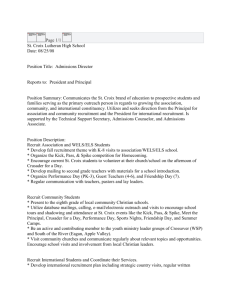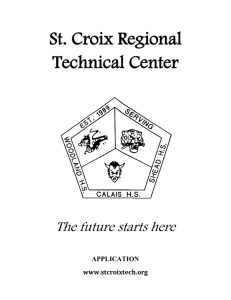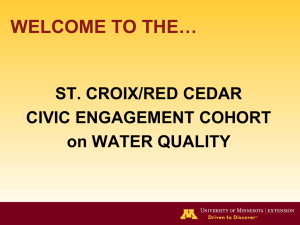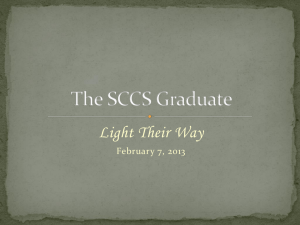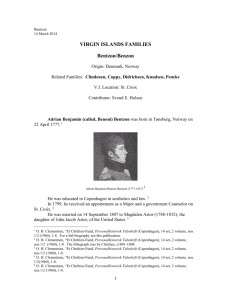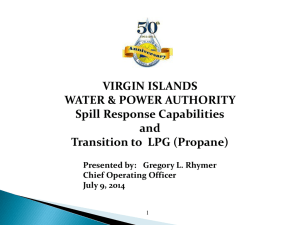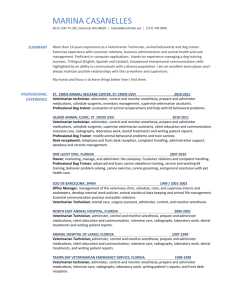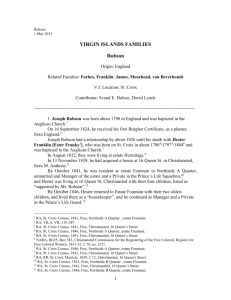ANTH 370 & 498: The Environment, People, and Culture of St
advertisement
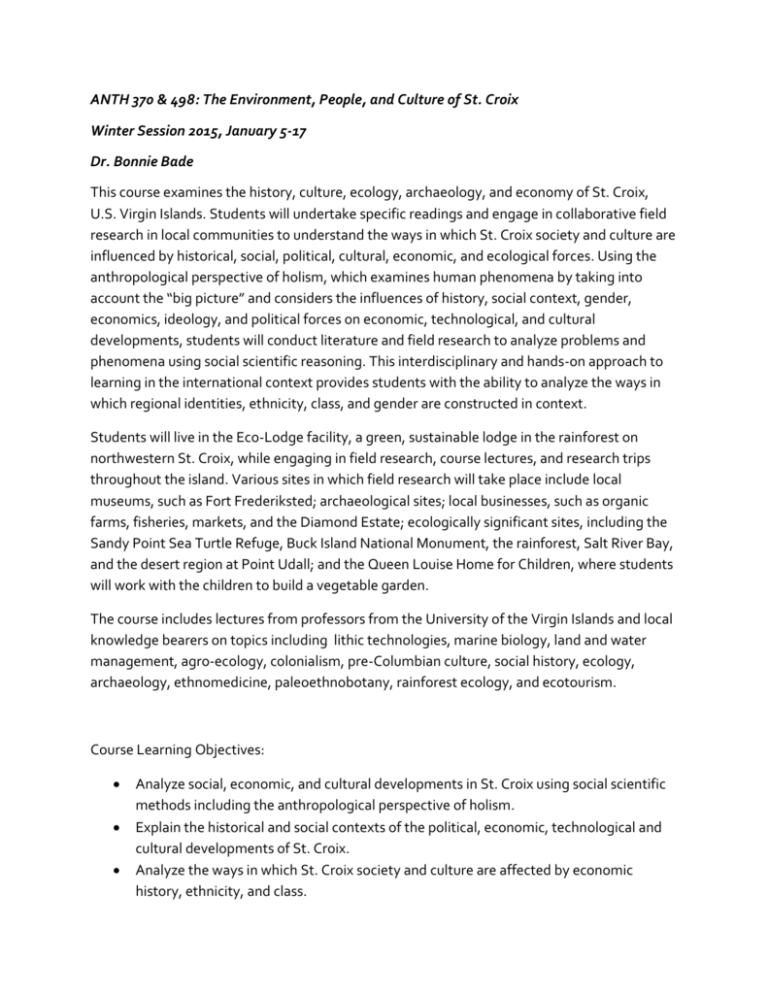
ANTH 370 & 498: The Environment, People, and Culture of St. Croix Winter Session 2015, January 5-17 Dr. Bonnie Bade This course examines the history, culture, ecology, archaeology, and economy of St. Croix, U.S. Virgin Islands. Students will undertake specific readings and engage in collaborative field research in local communities to understand the ways in which St. Croix society and culture are influenced by historical, social, political, cultural, economic, and ecological forces. Using the anthropological perspective of holism, which examines human phenomena by taking into account the “big picture” and considers the influences of history, social context, gender, economics, ideology, and political forces on economic, technological, and cultural developments, students will conduct literature and field research to analyze problems and phenomena using social scientific reasoning. This interdisciplinary and hands-on approach to learning in the international context provides students with the ability to analyze the ways in which regional identities, ethnicity, class, and gender are constructed in context. Students will live in the Eco-Lodge facility, a green, sustainable lodge in the rainforest on northwestern St. Croix, while engaging in field research, course lectures, and research trips throughout the island. Various sites in which field research will take place include local museums, such as Fort Frederiksted; archaeological sites; local businesses, such as organic farms, fisheries, markets, and the Diamond Estate; ecologically significant sites, including the Sandy Point Sea Turtle Refuge, Buck Island National Monument, the rainforest, Salt River Bay, and the desert region at Point Udall; and the Queen Louise Home for Children, where students will work with the children to build a vegetable garden. The course includes lectures from professors from the University of the Virgin Islands and local knowledge bearers on topics including lithic technologies, marine biology, land and water management, agro-ecology, colonialism, pre-Columbian culture, social history, ecology, archaeology, ethnomedicine, paleoethnobotany, rainforest ecology, and ecotourism. Course Learning Objectives: Analyze social, economic, and cultural developments in St. Croix using social scientific methods including the anthropological perspective of holism. Explain the historical and social contexts of the political, economic, technological and cultural developments of St. Croix. Analyze the ways in which St. Croix society and culture are affected by economic history, ethnicity, and class. Explain the role of the historical forces of migration, slavery, discrimination, and social justice on regional identities in St. Croix. Examine the many economic modalities employed on the island by residents and their relationship to the environment and the global economy. Understand the ecological diversity of St. Croix and its impact on economic, cultural, and social developments. Gain understanding of the diverse cultural and linguistic communities of St. Croix. Course Schedule: January 4: Arrival of students. Pick up at airport and transport to Eco-Lodge. January 5: Introduction to St. Croix, general safety information, social scientific methods of research and tools of analysis, the anthropological perspective. Lecture by Dr. Joshua Torres on Prehistory of St. Croix. Field trip to Christiansted for walking tour of historic district sites, including Danish West India Warehouse, Scale House, Steeple Building, Customs House, local businesses. Return to Eco-Lodge for dinner at West End. January 6: Field trip to Salt River, Columbus landing site, Taino Pre-Columbian ballcourt, Cape of Arrows and lecture by Shannon O’Neill. Field trip to Cane Bay Beach, Taino cultural site, and examination of Carib and Taino artifacts, lecture by Dr. David Goldstein on Ecology, Ethnogenesis, and Culture History of St. Croix. January 7: Sunrise field trip to Point Udall, hike to Jack and Issac Bay, lecture on marine ecology by Lance Hayes, visit to sea turtle nesting sites, Mt. Pellier Domino Club, and rainforest organic eco-farm. Lecture by David Hayes on the Archaeology and prehistory of St. Croix. January 8: Lecture by Mary Isaacs, Ethnomedicine and Paleoethnobotany of St. Croix, field trip to St. George Historic District sugar plantation and Botanical Gardens, time for work on projects, Rainforest Ecology lecture and Danish Ruins hike with Carmen Corradino, field trip to Ridge to Reef Organic Farm. January 9: Lecture by George Tyson on Social History of St. Croix, collaborative field research trip to Queen Louise Home for Children to build sustainable garden, lecture by Shannon O’Neill on Night Adaptations and Bioluminescence at Salt River. January 10: Lecture on the historical and social contexts of the political, economic, technological and cultural developments of St. Croix, field trip to Diamond Estate. Free afternoon. January 11: Free Day January 12: Lecture by David Hayes on the Archaeology of St. Croix, field trip to Christainsted to visit St. Croix archaeological museum, visit to Apothecary museum, free time in Christainsted. January 13: Field trip to local fish and farmers market to study local economic production, herbology, and food ecology. Lecture at Eco-Lodge by Lance Hayes on sustainable fishing and invasive marine species. Lecture, demonstration and application of methods by Matt Corradino on lithic technologies, Taino and Carib cultures, field trip to cay for demonstration and lecture on Carribbean culture. January 14: Lecture by Dr. Elizabeth Resende on Colonialism on St. Croix, field trip to Whim Museum, plantation and historic slave quarters, field trip to Frederiksted for lecture and tour of Fort Frederiksted National Landmark, free time in Frederiksted. January 15: Field trip to west end for Carambola tide pools and lecture by Lance Hayes on ecological diversity and marine-based economic production, time for work on projects, lecture by Michael Evans on Ecology of St. Croix and the US Virgin Islands, lecture on Buck Island history and ecology by Shannon O’Neill. January 16: Filed trip on sail boat to Buck Island for snorkeling at Underwater National Park and lecture on biodiversity. January 17: Free Day January 18: departures to Mainland, destination California. Lectures: Bonnie Bade, PhD, Medical Anthropologist. Anthropological tools of analysis, holism, selfreflection, collaborative field research, ethics. Lance Hayes, MS, Marine and Freshwater Biologist. Sustainable fishing, invasive species, marine research methods, biodiversity. Joshua Torres, PhD, Cultural Resource Program Manager, NPS St. Croix. Prehistory of St. Croix David Goldstein, PhD, Chief, Interpretation and Education, NPS St. Croix. Ecology, ethnogenesis, and culture history of St. Croix. Michael Evans, Refuge Manager, Sandy Point National Wildlife Refuge, United State Fish and Wildlife Service (USWFS). Ecology of St. Croix and the US Virgin Islands. George Tyson, PhD, Virgin Islands Social History Association (VISHA). Social history of St. Croix. Elizabeth Rezende, PhD, Professor, University of the Virgin Islands. Colonialism on St. Croix: Its History and Legacy. David Hayes, MA, Professional Archaeologist. The Archaeology and prehistory of St. Croix. Mary Isaacs, the “Rain Forest Lady.” Ethnomedicine and Paleoethnobotany of St. Croix. Shannon O’Neill, Archaeologist and Marine Ecologist. Night Adaptations and Bioluminescence, Buck Island Underwater National Park. Carmen Corradino, Rainforest Ecology and Danish Ruins Hike. Matt Corradino, Taino Lithics and Stone Tool Workshop Readings: Posted on Cougar Courses to be discussed in online forums. Assignments: 25% Field Notebook—you must keep a detailed field notebook that includes all activities, readings, lectures, thoughts, and other experiences while on St. Croix. 25% Discussion Forums—you will be put into online discussion groups in which you discuss the assigned readings. Study questions for discussion will be provided. 50% E-Book—you will make a book using Blurb.com that consists of a social scientific anaylsis of St. Croix using the anthropological perspective of holism. You can focus on one principle topic, but must provide the historical, social, cultural, political, ideological, and economic contexts in which the phenomena occurs. You will order three copies of the book: one for you, one for Anthropology, and one for the community in St. Croix on which you focus your research. Activity List: Botanical Gardens (The garden features over 1500 native and exotic species and varieties) The Estate St. George Historic District represents a successful late 18th-century sugar plantation. Owned by the Heyliger family during the era known as the "Golden Age of Sugar" (1770 to 1782), the estate continued to process sugar until 1916. After the closing of the largest sugar concern, Bethlehem Sugar Central in 1930, the estate became a cattle ranch. Presently used as a botanical park, the district includes factory ruins, a blacksmith shop, a two-story overseer's house, an early 19th-century slave/worker village, a lime kiln, cemetery and a water system with wells and an aqueduct. The Estate St. George Historic District is located on Centerline Rd., approximately four miles east of Frederiksted, in Prince Quarter, St. Croix, U.S. Virgin Islands. The estate has become the St. George Village Botanical Garden and many of the buildings have been restored. Salt River Bay This Salt River Bay site is the only known place where members of Columbus's expedition set foot on what is now U.S. territory, and was the site of the first armed clash between Europeans and American natives. On November 14, 1493, on his second voyage to the New World, Christopher Columbus sent a party of men ashore on St. Croix. Entering a deserted Carib village, the Spanish found a small group of Taino captives who agreed to accompany the Spanish to their ship. While returning, the Spanish encountered a canoe with a Carib war party which the Spanish tried to capture. In the ensuing fight one of Columbus' men was wounded by an arrow; several days later he died. The Spanish overturned the canoe, captured the occupants, and sent them to Spain. The area around the Salt River contains the remains of some 1500 years of Saladoid (Igneri), Ostinoid, Taino, and probably Carib occupation. During the Taino occupation, the area served as the seat of a chiefdom, which contained an important religious structure, and a ball and dance court. Over 100 years of archeological investigations have demonstrated that the Salt River area was the focus of the most extensive and intensive prehistoric occupation in the U.S. Virgin Islands. Point Udall Visitors on St. Croix travel to Point Udall, the eastern most point in the United Stated by travel, to be the first in the U.S. to see the sunrise. In 2000 Millennium Monument, a large sundial was built on the point for the New Year's celebration in 2000 — it marks the azimuth of the first U.S. sunrise of that year. After the sunrise, a 20-30 minute hike down to the water leads to Jack and Isaac’s bays, which are completely uninhabited. Right off the beach you will find amazing snorkeling and beautiful coral reefs. Whim Museum One of the most prosperous sugar plantations of the 17th,18th and 19th centuries, Whim Plantation also processed sugar cane from nearby plantations. Records dating back to 1751 give the original owner as Patrick Donough. Christopher Mac Evoy, Jr., a Danish sugar planter who inherited the plantation from his Scottish father, enlarged the estate with the Whim Great House in 1794. After changing hands several times, Whim became the property of the Virgin Islands Government and is operated as a museum by the St. Croix Landmarks Society. The Whim Great House and dependencies stand as an example of Danish neo-classicism as adapted for use in the West Indies. The site of an old slave quarters lies just north of the Tshaped complex and a working windmill stands as a monument to a vanished era of Caribbean history. Carmbola Tide Pools The Carmbola tidepools are accessible on the north side of the island near the Carmbola resort. Reaching the pools requires a 40 minute scenic hike which will end when you reach numerous tide pools and a pebble beach. In the pools you can swim and see a variety of marine life including eels, other fish, and invertebrates. Queen Louise Home for Children Queen Louise Home for Children is located 5 miles outside of Frederiksted town on St. Croix. Cottages A & B provide temporary placement in a family setting for children ages birth to 12 who have been the victims of abandonment, abuse or neglect. It is staffed by full-time childcare workers and by AmeriCorps Volunteers. Students will visit the home and spend time with the children to complete a garden project with the children to benefit the orphanage. Students will be asked to help the children build and make a small garden with local plant species on site at the orphanage. Christiansted and the Christiansted National Historic District Christiansted is one of the two towns on St. Croix and is home to many interesting historical sites, restaurants, shops, and a beautiful boardwalk located on the water. Christiansted has preserved the 18th-century Danish-style buildings constructed by African slaves. Solid stone buildings in pastel colors with bright red tile roofs line the cobblestone sidewalks, adding a touch of 18th-century European architectural style. Because the town was constructed by African slaves, there are many African influences in Christiansted's design as well, making it one of the few "African-Danish" towns in the world. The Christiansted waterfront is home to the Christiansted National Historic District, which was established as a National Historic Site in 1952. The five historical structures exist on the site are the Fort Christiansvaern, the Scale House, Danish Custom House, Steeple Building, and the Danish West Indie & Guniea Company Warehouse. The goal of this site is to preserve the historic structure and illustrate the Danish influence here between 1733 and 1917. St. Croix Archaeological Society The St. Croix Archaeological Society, located in Christiansted, focuses on the pre-Columbian and Historic archaeology of St. Croix. The small museum houses artifact from around the island. Frederiksted Frederiksted is the second town on St. Croix located on the West side of the island. The town is home to many beautiful beaches, restaurants, shops, a large pier, and Fort Frederik. Fort Frederik was built in the 18th century out of necessity by the Danish government to protect St. Croix against invasion of European powers, smugglers and pirates! It gained its status as a National Landmark because of the role it played in two events that eventually led to the dissolution of slavery in the Virgin Islands in 1848. In 1848, the Emancipation Revolt ended slavery in the Danish West Indies, but inaugurated a 30-year period of serfdom based on contract labor that ensured continuing control by plantation owners. Then in 1878, escalating tensions erupted into the Labor Riot and Fireburn, which ended the contract labor system. Buck Island sailing and snorkeling to study marine ecology Buck Island is six thousand feet long and a half mile wide, rises to 340 feet above sea level and lies 1.5 miles off the northeast side of St. Croix. The 19,000 acre Buck Island Reef National Monument includes 176 acres of land, which has an overland nature trail and white coral sand beaches, is a haven for endangered brown pelicans and a nesting area for three species of sea turtles, and 4,554 acres of water and coral reef system. Accessible only by boat, the island is home to the United States’ only underwater national park. In this park lies an underwater snorkeling tour path with information about what you can see snorkeling. The students will enjoy a sailboat trip to the island, a snorkel tour, and the chance to explore the island. Turtle Beach on Buck's west end has been voted one of the world's most beautiful beaches by National Geographic. Apothecary Hall Museum: Located in the heart of Christiansted, is an authentically furnished, nineteenth-century Danish Colonial pharmacy filled with exotic apothecary bottles, drawers of dried and powdered medicines, and antique pharmacy equipment. The pharmacy was established in 1820 by a Danish pharmacist who arrived in St. Croix to prepare medicines for the Danish military garrison in Christiansted, then the capital of the Danish West Indies. The pharmacy served St. Croix for more than 140 years. Initially, medicines were manufactured for the Danish soldiers as well as the other physicians and pharmacists in the Danish West Indies. Unlike the addictive opium-containing medicines widely used in the United States at the time, the Danish pharmacists practiced what is known as "heroic medicine." This consisted of dispensing harshly-acting chemical compounds of antimony, lead, and mercury to treat ailments that they understood even less than the drugs they were administering to their patients. The last owner of this pharmacy continued to operate it until he retired in 1970, when he donated his handsome drug jars and pharmaceutical equipment to the St. Croix Landmarks Society. The fully restored pharmacy opened in its original location in 1987. Today the pharmacy is used as an exhibit for the public. Ridge to Reef Farm We will visit the farm and take an insightful and delightful walk with Jillian to learn about the farm, its mission, and see first-hand the inner workings of the certified organic system. She will show you the fruits, animals, and plants that make the farm thrive. Taste test crops while standing in the 100 person Community Supported Agriculture (CSA) fields! Also get an inside look of the solar powered off-grid community center, the Taino inspired bohio hammock house, treehouse, talapia pond, and more! Taino Stone Tool Workshop: Matt Corradino is an expert in wilderness survival, the Taino culture, and stone tools. The students will participate in a workshop that includes information about different types of Taino stone tools found on the island, how they were made, and general information on lithic analysis. Historic Diamond Estate: Students will be taken on a guided tour of a historic plantation called Diamond Estate. The tour includes information about the islands rich history and a background of the old sugar plantation and how it has changed over time. Students will see firsthand how and why the plantation made the change from sugarcane to molasses, and how the current distillery process works. Academic Honesty: Each student shall maintain academic honesty in the conduct of his or her studies and other learning activities at CSUSM. The integrity of this academic institution, and quality of the education provided in its degree programs, are based on the principle of academic honesty. The maintenance of academic honesty and quality education is the responsibility of each student within this university and the California State University System. Cheating and plagiarism in connection with an academic program at a campus is listed in Section 41301, Title 5, California Code of Regulations, as an offense for which a student may be expelled, suspended, put on probation, or given a less severe disciplinary sanction. See General Catalog or (http:/wwww.csusm.edu/acadmicprograms/catalog/) for more information on the Academic Honesty Policy. ADA Statement: Students with disabilities who require reasonable accommodations must be approved for services by providing appropriate and recent documentation to the Office of Disabled Student Services (DSS). This office is located in Craven Hall 4300A, and can be contacted by phone at (760) 750-4905, or TTY (760) 750-4909. Students authorized by DSS to receive reasonable accommodations should meet with the Department Chair during his or her office hours in order to ensure confidentiality.
